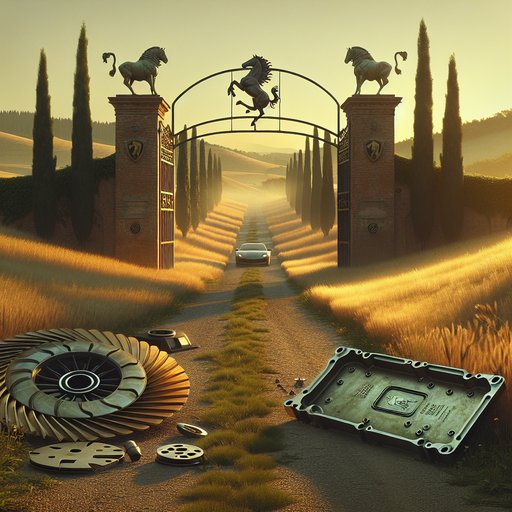
In the flat fields between Bologna and Modena, two emblems faced one another across hedgerows and centuries: a prancing horse painted on factory gates in Maranello, and a snorting bull cast in bronze in Sant’Agata Bolognese. The story of Ferrari and Lamborghini is not a tale of wheel-to-wheel duels as much as it is a contest of pride, engineering, and the stubborn refusal to be second. It begins with a clutch plate and ends—so far—with electricity humming beneath carbon tubs, but the middle is all gasoline, metal, and the heat of Italian summers.
The story opened not with banners but with a workbench. Ferruccio Lamborghini, an industrialist whose tractors tilled the same soil that had fed Modena for generations, laid a worn clutch disc beside one from his own machines. The Ferrari in his garage had a temperament he didn’t care for, bucking and burning through components he understood too well. Accounts say he drove to Maranello to make a point.
What was said in that office remains contested, but the body language in photographs from the era—Enzo Ferrari’s chin fixed like a plumb line, Ferruccio’s thick hands always moving—tells you enough about how it felt. By 1963, there was no going back. A new factory rose in Sant’Agata, a modern, airy place with pale floors, machines arranged like geometry, and quiet confidence in the air. He hired people who knew speed better than anyone: Giotto Bizzarrini to coax a V12 from raw metal; Gian Paolo Dallara and Paolo Stanzani to turn ideas into suspension pick-up points and gearbox casings; Bob Wallace to pound prototypes over the Apennines.
If Maranello was a monastery of racing, Sant’Agata sounded like the first note of a different hymn. The first cars were elegant rebuttals. The 350 GT and later the 400 GT rolled into showrooms with bodies formed by Carrozzeria Touring, V12s breathing easily through six twin-choke carburetors. They felt smoother than the Ferraris of the day, less demanding at low speeds, more grand tourer than temperamental thoroughbred.
Across the plain, Ferrari watched but did not flinch; the 275 GTB carried on with its long nose and short deck, its subtlety the opposite of Sant’Agata’s declarative newness. The two philosophies stood like dialects—related, mutually intelligible, but not the same language. Then the floor tilted. In 1966, at Geneva, Lamborghini pushed a low, lime-green shape under the lights.
The Miura stood impossibly flat, a transverse V12 mounted behind the seats, suspension knuckles gleaming, the body by Marcello Gandini at Bertone stretched like a cat. Crowds leaned over rope lines to stare into a rear clamshell that rose like a stage curtain. Ferrari had built mid-engined race cars for years, but his road cars kept their engines in front, the weight of tradition sitting over the front axle. The Miura changed the conversation for everyone in the hall, not through speeches but by quietly rearranging the map of what a road car could be.
Ferrari did what Ferrari always did: he reached into racing. The 206 and 246 Dino put the engine behind the driver, V6s singing into the hills, even if they wore a different badge to preserve Ferrari’s road-car philosophy. A few years later, the Berlinetta Boxer arrived with a flat-12 mounted amidships and a name meant to say the misgivings had been put to bed. Lamborghini’s response was not reactionary; it was radical.
The Countach arrived like thunder in 1974, the wedge cut so sharp you could feel it in your palm. Doors swung upward, intakes grew with each evolution, and children taped its poster to their walls as if staking a claim on the future. Through the 1980s, the rivalry spun through turbulence and clarity. Lamborghini changed hands more than once; Ferruccio himself stepped away from the company he had willed into being.
Yet the cars kept coming, the Countach sprouting Quattrovalvole scripts and wider arches, the Diablo emerging in 1990 with a name that made sense when it passed at full throttle. Ferrari countered with the Testarossa’s wide hips and heat-dissipating strakes, and then with the F40, a plexiglass and Kevlar rejoinder from a company celebrating forty years by taking off anything that wasn’t necessary. If Lamborghini’s big V12s were cathedrals, the F40 was a stripped-down chapel where only the essential mattered. Racing did not settle the argument because it was never the battleground.
Ferrari had the crimson tide of Formula One, a culture of lap charts and pit boards and parades in Maranello each time a title came home. Lamborghini flirted with F1 engines, the V12 running in the back of Larrousse and other teams in the early 1990s, even turning laps in a McLaren test car, but victories did not follow. Instead, Sant’Agata built its own arenas—one-make series for Huracáns, GT3 campaigns where customer teams found trophies—and defined success in the glare of showroom glass, where sound and silhouette swayed decisions as surely as lap times. The late 1990s brought a corporate calm that changed the tempo.
Audi’s stewardship sharpened processes without sanding away the edges. The Murciélago felt stout in ways the Countach never did, its V12 bellowing toward redline with a tolerance for daily indignities the old cars refused to learn. The Gallardo carried that ethos into volume, V10s crackling down Corso Canalchiaro among bicycles and gelato carts. Ferrari matched with the 360 Modena’s glass engine cover and the F430’s serious front intakes, then with the 458 Italia, a car that made steering feel like a secret passed palm-to-palm.
The two companies used different recipes: Lamborghini built drama into the stance and the start-up, Ferrari put speed in your fingertips and shoulders and left the noise to arrive as proof. On the Nordschleife, the script wrote itself even when one party declined to perform. Lamborghini sent the stopwatches spinning—Huracán Performante first, then Aventador SVJ, each lap like a manifesto delivered in six minutes and change. Ferrari did not play that game in public; they rarely chase the Ring with cameras rolling, favoring private validation and the quiet authority of racing silverware.
The argument became metaphysical. What is fast? What is exciting? What belongs on a podium, what belongs on a poster, and how often are those two the same thing?
Under the carbon lids, technology changed as quietly as any revolution. Turbochargers returned to Ferrari road cars with the 488, humming behind subtle sound tuning that let spool and wastegate whisper without stealing the melody. Hybridization arrived with the LaFerrari, and then with the SF90 and 296, energy reclaimed under braking and redeployed like a second wind. Lamborghini held the naturally aspirated line as long as possible, the V10 and V12 singing unassisted until regulations tightened and thermodynamics said enough.
The Revuelto appeared with electric motors twined around a new V12, the sound still there, augmented now by the faint turbine whine of regeneration. The badge in Sant’Agata’s courtyard did not change; it simply glinted differently at dusk. Walk outside either factory and you can trace history in the roads. The Apennine passes test cooling systems and second-gear traction; the autostrada reads high-speed stability and the courage of braking zones.
Workers leave their shifts on bicycles and mopeds, the heavy doors sighing behind them. In local cafés, old men remember the day the Miura blocked a lane because everyone came out to look, and younger ones pull phones to show the perfetto line through Variante Ascari. Rivalry, in that place, feels less like a feud than like a weather system—sometimes storm, sometimes high blue skies, always present. What comes next remains unresolved by design.
Batteries and software shift the game into domains that favor silence and simulation, yet neither marque seems inclined to let character be a casualty. Ferrari leans on racing to explain why electricity can be passion; Lamborghini leans on theater to show why a start button can still feel like a ceremony. They remain separated by kilometers of philosophy and joined by one narrow strip of tarmac that runs through Italy’s Motor Valley, where fields reflect the sky and sometimes the glint of aluminum passes across the rows as if reminding the soil itself to be ambitious. The fierce part of their rivalry is not anger but insistence.
Each insists that its way—measured in noise, in numbers, in the way forearms tense on a wheel—matters most. The audience gets to choose, and the choice has never been simple. Somewhere between Maranello’s test track and Sant’Agata’s first shift bell, a story that began with a clutch plate keeps turning like a flywheel, heavy with history and ready to store the next burst of energy. The future will decide if the sound changes or simply finds a different frequency, but the contest will still be felt in the chest more than heard with the ears.








































